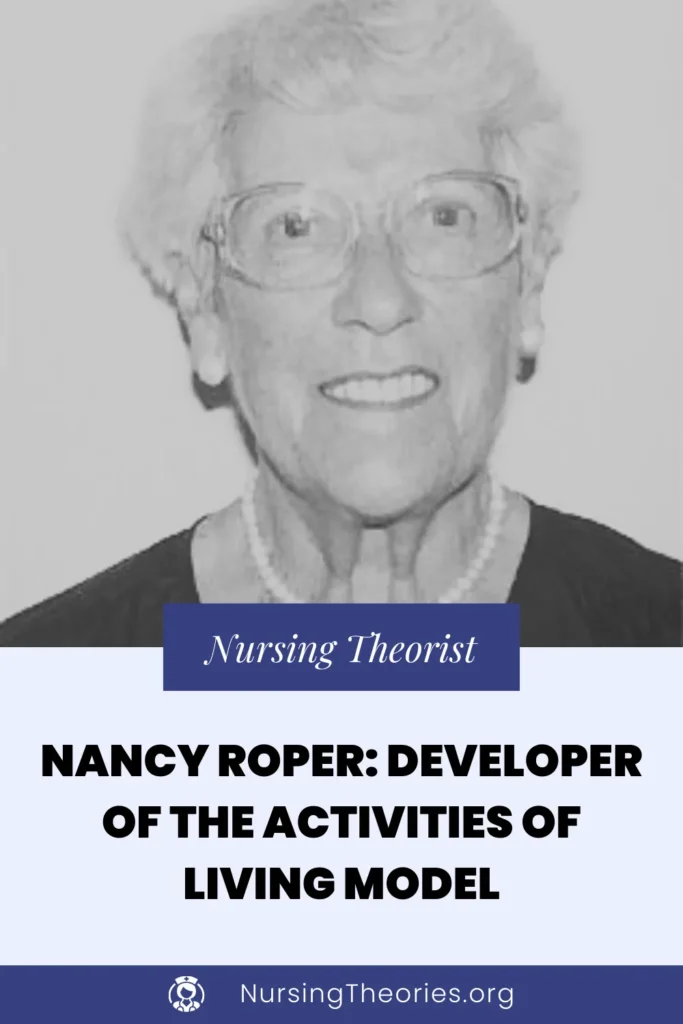Nancy Roper, a prominent British nurse theorist and researcher.
She is widely recognized for her collaborative work with Alison Tierney and Winifred Logan in developing the Roper-Logan-Tierney Model of Nursing, a foundational framework for assessing and addressing patients’ daily living needs.
Their work focuses on evaluating the impact of illness or injury on a patient’s ability to perform essential activities and guiding nursing interventions accordingly.
Their Combined contributions have played a pivotal role in promoting holistic and patient-centered nursing care.
In this article, we cover Nancy Roper’s life, achievements, philosophy, and lasting impact on modern nursing.

Quick Summary
- Developed the Activities of Living Model, which emphasizes assessing and supporting patients’ ability to perform daily tasks.
- Advocated for holistic, individualized care by addressing physical, psychological, and social needs.
- Co-authored the Roper-Logan-Tierney Model, widely adopted in nursing education and practice globally.
- Emphasized the importance of promoting independence and quality of life in nursing interventions.
- Recognized for her contributions to the advancement of nursing assessments and patient care planning.
Early Life and Background of Nancy Roper

Birth and Family Background of Nancy Roper
- Nancy Roper was born on September 29, 1918, in Wetheral, England, into a family that valued education and community service.
- Her early exposure to healthcare settings and community support initiatives shaped her interest in nursing and patient welfare.
Education and Early Influences in Roper’s Life
- Roper trained as a nurse at Cumberland Infirmary and later pursued a bachelor’s degree in nursing.
- She continued her education with advanced studies in nursing research, which laid the foundation for her theoretical contributions.
- Her clinical experiences inspired her to develop a framework for understanding patients’ individual needs and improving nursing interventions.
Nancy Roper’s Philosophy and Vision for Nursing
- Roper believed that nursing should be centered on helping individuals maintain or regain their independence by addressing essential daily activities.
- Her vision emphasized the importance of assessing not only physical health but also psychological, social, and environmental factors.
- Famous quote: “Nursing is about enabling people to live as independently and fully as possible.”
Nancy Roper’s Education and Early Nursing Career
Formal Education and Nursing Training of Nancy Roper
- Roper’s education in nursing science and research provided her with a comprehensive understanding of patient-centered care.
- Her studies focused on creating effective nursing assessments that address both immediate and long-term patient needs.
Early Professional Experiences in Roper’s Career
- Roper worked as a clinical nurse and later transitioned into teaching and research roles.
- Her experiences in hospitals and community settings highlighted the need for a standardized framework to assess patients holistically.
Key Achievements and Contributions of Nancy Roper
Development of the Activities of Living Model
- Roper’s model focuses on 12 activities of daily living (ADLs) that are essential for maintaining independence and well-being:
- Maintaining a safe environment
- Communicating
- Breathing
- Eating and drinking
- Eliminating
- Personal cleansing and dressing
- Controlling body temperature
- Mobilizing
- Working and playing
- Expressing sexuality
- Sleeping
- Dying (as a natural process of life)
- The model guides nurses in assessing the impact of illness or injury on these activities and tailoring interventions to support recovery and independence.
Contributions to Nursing Education and Curriculum Development
- Roper’s model was integrated into nursing curricula worldwide, providing a structured approach for assessing patient needs.
- She designed teaching materials that encourage students to consider the whole patient rather than focusing solely on physical symptoms.
Research and Theoretical Advancements
- Roper conducted extensive research on the relationship between health, independence, and quality of life, providing empirical support for her model.
- Her studies demonstrated that addressing ADLs leads to improved patient outcomes and satisfaction.
Global Impact and Recognition
- The Roper-Logan-Tierney Model, co-authored by Roper, has been adopted in nursing education, research, and clinical practice globally.
- Roper received numerous accolades for her work in developing nursing assessment tools and promoting individualized care.
Overview of Nancy Roper’s Activities of Living Model
- The model emphasizes the assessment of patients’ ability to perform essential daily activities and guides nursing interventions accordingly.
- By addressing physical, emotional, and social factors, the model promotes holistic, patient-centered care.
- To explore this theory in greater depth, visit the in-depth article on the Roper-Logan-Tierney Model of Nursing.
Notable Publications by Nancy Roper
- The Elements of Nursing – A key text that outlines her model and its application in nursing practice.
- Nursing Practice and Health Care – A publication that emphasizes patient assessments and care planning.
- Numerous articles on activities of daily living, patient-centered care, and nursing research.
Challenges and Criticisms of Nancy Roper’s Work
Challenges in Applying the Model in Complex Settings
- Some nurses have found it challenging to apply the model comprehensively in high-pressure environments, such as emergency rooms.
- Roper suggested that flexibility and prioritization are essential when applying the model in different settings.
Criticisms of the Model’s Generalization
- Critics argue that the model may not fully address complex or unique cases, such as patients with multiple comorbidities.
- However, proponents highlight that its adaptability allows for customization based on individual needs.
Timeline of Major Milestones in Nancy Roper’s Life
- 1918: Born in Wetheral, England.
- 1940s: Trained as a nurse and began her clinical career.
- 1970s: Developed the Activities of Living Model.
- 1980s: Published The Elements of Nursing in collaboration with Winifred Logan and Alison Tierney.
- 2004: Passed away, leaving a lasting legacy in nursing theory and practice.
Legacy and Lasting Impact of Nancy Roper
Impact on Nursing Practice and Patient Care
- Roper’s model has enhanced nursing assessments and interventions by addressing patients’ functional, emotional, and social needs.
Global Influence and Recognitions
- Her work is taught in nursing schools worldwide and applied in various healthcare settings.
- Roper’s contributions have earned her numerous posthumous honors and recognition as a pioneer in holistic nursing care.
Final Years and Passing of Nancy Roper
- Roper continued to mentor students and contribute to nursing research until her passing in 2004.
- Her legacy lives on through the widespread application of her model in nursing education and practice.
Key Lessons from Nancy Roper for Modern Nursing
- Holistic assessments: Addressing physical, emotional, and social factors leads to comprehensive patient care.
- Promoting independence: Encouraging patients to regain or maintain independence improves quality of life.
- Patient-centered interventions: Tailoring care to individual needs enhances recovery and satisfaction.
- Flexibility in application: Adapting assessments and interventions to different clinical settings is essential.
- Continuous learning: Nurses should stay updated on new approaches to effectively apply holistic assessments.
Conclusion
Nancy Roper’s Activities of Living Model, developed in collaboration with Winifred Logan and Alison Tierney, has transformed nursing by promoting comprehensive assessments and personalized interventions.
Their combined work, explored further in the in-depth article on the Roper-Logan-Tierney Model of Nursing, continues to guide nursing practice globally.
The legacy of Roper, Logan, and Tierney endures as their model remains central to improving patient outcomes, independence, and overall well-being.


